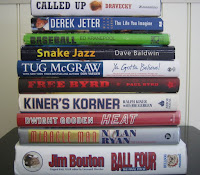-Aristotle
I was watching "Hot Stove" on MLB Network today and they were discussing the increase of Tommy John surgeries not only among MLB Players but also among college, high school and even middle school baseball players! At the end of the piece they were wondering "why". Why?? Anyone who has witnessed the "win at all costs" attitude of youth sports can figure it out. Take for instance the pitcher in middle school who can throw 80 MPH (darn good for that level) and is striking out almost everyone he faces. Why tinker with him even though his delivery is akin to Mark Pryor's (aka - a disaster)? God forbid they should step back and take a look at his pitching motion and maybe show him a thing or two about a sound delivery. They could have saved him from pain.
And it's not just about baseball or even injury. Take the girl with the crazy jumpshot that scores a ton of points in AAU but when she hits high school her body grows into something that can no longer support that shot (bye bye scholarship). Or the football player that receives one of the many youth related injuries and winds up selling dimebags on the corner (do they even have dimebags anymore? Do they even sell them on the corner?) Regardless, the leaders of youth sports need to step up and address these issues. I consider myself optimistic, but not sure if this is going to happen.
I'd love to hear thoughts on this ...
"Oh, thank you so much! Now we can go back to the Wizard, and tell him the Wicked Witch is dead! "
-Dorothy, The Wizard of Oz
 Now on to the second part of this post. The witch is dead! The 14 year witch that is. The CBA was signed yesterday and one of the points in it was to rid baseball of the All-Star game having an impact on home-field advantage in the World Series. There are rules and regulations in all sports in which fans do not agree with. Most of these have cons as well as a few pros, but having the outcome of the All-Star game determine home field advantage in the World Series is just plain dumb with no pros that I can see.
Now on to the second part of this post. The witch is dead! The 14 year witch that is. The CBA was signed yesterday and one of the points in it was to rid baseball of the All-Star game having an impact on home-field advantage in the World Series. There are rules and regulations in all sports in which fans do not agree with. Most of these have cons as well as a few pros, but having the outcome of the All-Star game determine home field advantage in the World Series is just plain dumb with no pros that I can see.I despised this for two reasons.
Picture if you will (I'm channeling my inner Rod Serling) - The American League all-star team has about 60% of its players from teams in contention for a playoff spot. The National League all-star team has only 40% of contending players on their team. With that silly rule in place this tells you the American League players are going to take the game a little more seriously than the senior circuit players will. As a bonus con to this reason there can be some bitterness among players who are on teams in contention toward players of teams who are not in contention and are dogging it.
Forcing players to take a game seriously that has in the past typically been viewed as fun, can cause injury. How would upper (and lower) management of a team feel if their star player was injured playing a little too hard during the all-star game? Looks like their playoff chances aren't so good anymore huh?
Thanks for reading
-Tom










